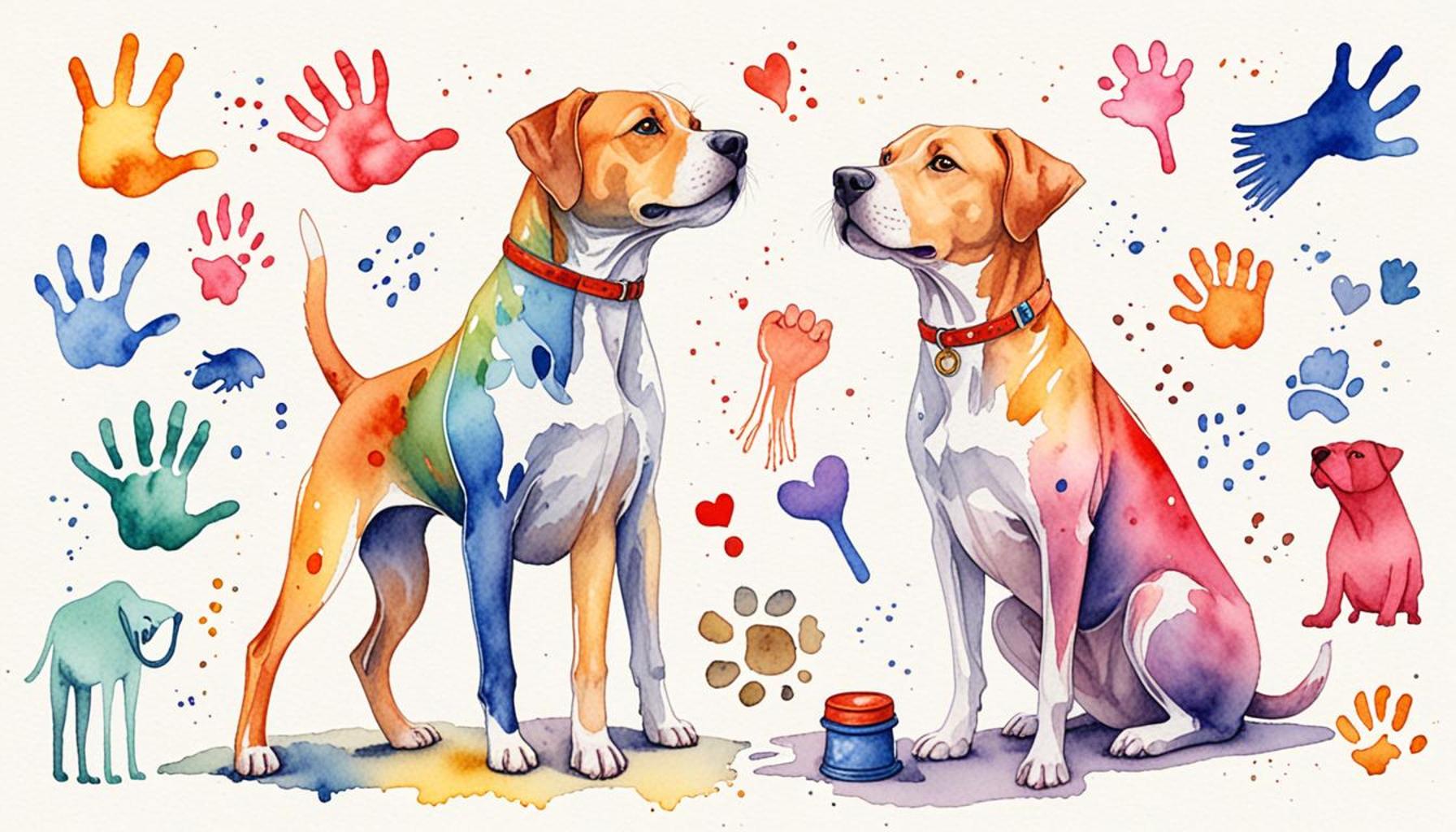Understanding Canine Body Language: A Key Element in Successful Training

Decoding Canine Communication
Every dog owner knows that their furry friend communicates far beyond mere barks or howls. Understanding canine body language is essential for fostering a strong bond and successful training. Dogs have a rich array of signals that can clarify their feelings, intentions, and needs, making it pivotal for owners to learn these non-verbal cues.
Recognizing a dog’s emotions can make a significant difference in training effectiveness. When you decipher these cues accurately, you can respond appropriately, ultimately leading to a more harmonious relationship with your pet. Consider these key elements that serve as the building blocks of canine communication:
- Tail Position: The position of a dog’s tail can convey a multitude of emotions. A tail held high and wagging excitedly often indicates happiness and eagerness to engage, while a tucked tail between the legs is a classic sign of fear or submission. Different breeds express these signals uniquely; for instance, a Labrador’s wagging tail is more pronounced than that of a Greyhound, whose tail might rest low even in comfort.
- Ear Posture: Erect ears signify alertness and curiosity, showing that a dog is keenly observing its surroundings. In contrast, pinned-back ears usually indicate anxiety or a desire to appease, especially during stressful situations. For example, when meeting other dogs or new people, pay attention to their ear position to gauge their feelings.
- Body Stance: A relaxed, loose body posture indicates comfort and contentment, while a stiff, tense body often reflects aggression or apprehension. For example, if a dog stands tall with rigid legs and a forward-leaning posture, this could suggest that it perceives a threat.
By paying attention to these cues, dog owners can enhance their understanding of their pet’s emotional state. Interestingly, some behaviorists suggest that dogs not only communicate with their owners but also with each other through these signals. A dog’s body language provides insight not just for training but also for daily interactions, helping to resolve conflicts and enhance the quality of life for both the animal and its owner.
Successful training requires a deeper connection between you and your dog. You can create an environment conducive to learning and trust by being observant and responsive to your dog’s emotional landscape. Ultimately, being attuned to canine cues fosters a more harmonious relationship and effective communication.
In this article, you will discover the nuances behind these signals and learn practical tips to refine your training techniques. For instance, implementing positive reinforcement based on your dog’s emotional responses can drastically improve their learning experience. Unraveling these signs could be the key to unlocking your dog’s full potential, leading to a more satisfying interaction for both pet and owner.
For further insights, consider observing your dog in various environments. Notice how their body language changes when in the park compared to being at home. This exercise can offer more profound insights into your dog’s personality and emotional reactions, urging you to dig deeper into the fascinating world of canine communication.
DISCOVER MORE: Click here for essential pet safety tips
The Subtle Signals of Canine Body Language
Understanding canine body language is more than just a tool for training; it is an essential aspect of building a healthy and trusting relationship with your dog. Dogs communicate predominantly through their body language, often conveying messages that we, as humans, may overlook. By grasping these signals, dog owners can foster a more effective training environment and a deeper connection with their pets.
To effectively interpret your dog’s feelings and intentions, it’s crucial to look beyond the obvious behaviors and observe the subtleties within their body language. Here’s a breakdown of various elements that play a significant role in canine communication:
- Facial Expressions: A dog’s facial expressions can reveal a lot about their mood. For instance, a dog with soft, relaxed eyes and a slightly open mouth is often at ease and comfortable. In contrast, squinting eyes combined with a tense mouth signal anxiety or discomfort. Paying attention to your dog’s face can help you gauge their emotional state effectively.
- Vocalizations: Although we often associate vocalizations with barking, dogs also use other sounds such as growling, whining, and howling to communicate. Each noise carries a different meaning; for example, a low growl can be a warning, while high-pitched whines may indicate excitement or distress. Observing these vocalizations alongside body language aids in a comprehensive understanding of your dog’s feelings.
- Play Bow: One of the most positive body language signals comes in the form of a “play bow,” where a dog lowers their front legs while keeping their rear end up. This playful gesture indicates that the dog is ready for interaction and wants to engage with others, whether it’s another dog or a human. Recognizing this cue is essential for creating enjoyable play sessions.
Recognizing these subtle signals allows dog owners not only to respond more effectively to their pet’s needs but also to preempt potential issues. When canine behavior is misinterpreted, it can lead to stress or behavioral problems, exacerbating the challenges of training. Understanding what your dog is trying to convey can facilitate a more constructive training process, minimizing misunderstandings and enhancing the learning experience.
Moreover, being able to differentiate between a relaxed and a stressed dog can significantly impact training sessions. For example, if your dog displays signs of discomfort or fear—such as avoiding eye contact or showing a rigid posture—it may be time to slow down and reassess your approach. Tailoring your training techniques to your dog’s emotional condition is key to unlocking their full potential.
In the next sections, we will delve deeper into additional body language signals, providing you with a detailed guide to interpreting these cues accurately. With an understanding of your dog’s emotional landscape, you can apply effective training methods that cater to their needs, shaping a more harmonious relationship and ensuring a fulfilling journey together.
| Aspect of Body Language | Significance in Training |
|---|---|
| Tail Position | Understanding a dog’s tail position can indicate their mood—high and wagging means happiness while low could signal fear. |
| Eye Contact | Successful training relies on interpreting whether a dog feels relaxed or threatened based on their eye contact. |
| Ears | Alert or relaxed ears provide insight into a dog’s emotional state, essential for tailoring training responses. |
| Body Posture | A dog’s stance can reveal whether they are ready to engage or feeling defensive—crucial for effective interaction. |
Understanding canine body language is not merely a skill; it’s an essential component that leads to successful training. By paying attention to nuances such as tail position, eye contact, ear orientation, and body posture, dog trainers can foster more effective communication and trust with their canine companions. For instance, a tail raised and wagging might signal excitement and readiness for learning, while a low tail may indicate apprehension. Such insights enhance the ability to respond proactively rather than reactively, making the training process smoother and more harmonious. Pet owners and trainers alike are encouraged to delve deeper into the world of canine communication, as mastering this skill opens pathways to richer interactions, reduces misunderstandings, and ultimately leads to more fulfilling relationships with our loyal companions.
DIVE DEEPER: Click here for essential adoption resources
Deciphering Stress Signals and Calming Techniques
In addition to understanding the positive signals in canine body language, it is equally important to recognize when your dog is under stress. Canine stress signals can often be subtle yet crucial indicators of a dog’s emotional state. Dogs may exhibit different behaviors when they are anxious or uncomfortable, sabotaging the effectiveness of any training efforts. Learning to decipher these signals enables trainers to intervene proactively, ensuring that training sessions remain positive and constructive.
Common stress signals include yawning, lip licking, and excessive panting. A dog that yawns repeatedly during a training session may not be bored; instead, it could signify that they are feeling overwhelmed or uncertain. Likewise, if your dog is licking its lips or flicking its tongue frequently, these behaviors may indicate anxiety or discomfort. Recognizing these cues allows you to adapt your training strategies to create a supportive atmosphere.
Another significant stress sign is the dog’s tail positioning. A tail that is tucked between the legs signals fear, while a wagging tail in a high position generally indicates happiness or excitement. However, if the tail wags stiffly, it can represent alertness or potential aggression. Understanding these nuances helps prevent unnecessary tension and exposes the dog to a calmer training environment.
When dogs exhibit signs of stress, effective training does not just mean pushing through exercises. Instead, it is essential to utilize calming techniques to ease their discomfort. Techniques like deep pressure therapy, where you apply gentle yet firm pressure to help soothe your dog, can be beneficial. Additionally, creating a “safe space” for your dog within your home, such as a designated quiet area equipped with familiar items like their bed or toys, can significantly reduce anxiety.
Incorporating positive reinforcement is another powerful method to alleviate stress during training. Rewarding your dog with a treat or praise any time they exhibit calm behavior can reinforce the idea that good things happen when they are relaxed. Moreover, using high-value treats will keep your dog’s focus on you, reducing their anxiety and enhancing their willingness to engage during training.
It is also worth noting that the environment plays a critical role in canine body language. Dogs are highly sensitive to their surroundings, and factors like noise levels, unfamiliar people, or other pets can influence their behavior. When training in public places, consider your dog’s comfort level. Gradually acclimatizing them to new environments can improve their overall adaptability, fostering a more harmonious relationship between you and your pet.
Finally, for dogs with more pronounced anxiety issues, seeking professional help from a certified trainer or animal behaviorist can provide an additional layer of support. These experts can teach you how to read various stress signals more accurately, offering tailored strategies that fit your dog’s unique needs.
As we delve deeper into the world of canine communication, understanding your dog’s body language can pave the way for successful training outcomes. By mastering the signs of stress and employing effective calming techniques, you can create a nurturing and productive training environment that fosters a lasting bond with your furry companion.
LEARN MORE: Click here to discover positive reinforcement strategies
Conclusion: A Foundation for Trust and Understanding
Grasping the nuances of canine body language is not merely an academic pursuit; it is a vital component of effective dog training that fosters trust and enhances communication between you and your furry friend. By becoming adept at interpreting your dog’s physical cues, whether they be signs of comfort or indicators of stress, you position yourself as a compassionate trainer who responds to your dog’s needs rather than imposes techniques that may exacerbate anxiety.
This understanding extends beyond the confines of training sessions. The ability to read your dog’s body language can enhance your daily interactions and contribute to a harmonious living environment. Recognizing signs of discomfort allows you to adapt your approach, while employing calming techniques creates a more positive experience for both you and your dog. As you fill your training toolbox with skills like positive reinforcement and environmental adjustments, you’re strengthening the foundation of your relationship.
Moreover, in a society where pet ownership is ever-growing, equipping yourself with knowledge about canine communication can lead to not only a better-trained dog but also a more balanced and happy pet. It opens the door to deeper insights into their emotions and behaviors, guiding you toward better care and understanding.
Ultimately, investing time in learning to interpret canine body language will enrich not just your training efforts but also the joyful moments you share with your dog. As you embark on this journey of mutual understanding, you will cultivate a bond that transcends basic obedience and evolves into a profound companionship filled with love, trust, and respect. For those seeking a harmonious life with their dogs, understanding canine body language is an indispensable key.



